649. Rudd's Apalis Apalis ruddi (Ruddse Kleinjantjie)
Order: Passeriformes. Family: Cisticolidae
Description
Size 11-12 cm, weight about 10 g. Olive back and uppertail. Grey head with white eyebrow and small black mask. White throat with a black line along the upper breast with yellow breast extending partway along the flank (less yellow in females). Females also have narrower breast band. White belly turning yellow again at the vent. Olive undertail with yellow tips to the tail feathers. The eye is dark brown.
Similar to the Bar-throated Apalis, which is lighter in color, has no eyebrow, and has a pale instead of brown eye.
Distribution
The main population is found between 22°S and 29°S on a broad coastal strip in southern Mozambique, north-eastern KwaZulu-Natal in South Africa, and eastern Swaziland; another isolated population is found in lowland southern Malawi.
Habitat
Coastal and riverine forests where it spends most of the time in the canopy. Generally found singly or in pairs.
Diet
It joins mixed-species feeding flocks. Forages actively for small insects and larvae, foraging at all levels of the forest, gleaning prey from leaves and twigs.
Breeding
Monogamous and territorial. The nest is an oval ball with an entrance near the top built by the male using grass and stems and camouflaged using moss, silk or lichen. One to three eggs are laid September to November. Nestlings are fed by both adults.
Call
Rapid tok-tok-tok-tok-tok. Listen to Bird Call
Status
Near-endemic and listed as Near-threatened.
Africa Wild Bird Book
Rudd's Apalis
Dewi
What is the good of having a nice house without a decent planet to put it on? (H D Thoreau)
What is the good of having a nice house without a decent planet to put it on? (H D Thoreau)
Rudd's Apalis Photos
649. Rudd's Apalis Apalis ruddi (Ruddse Kleinjantjie)
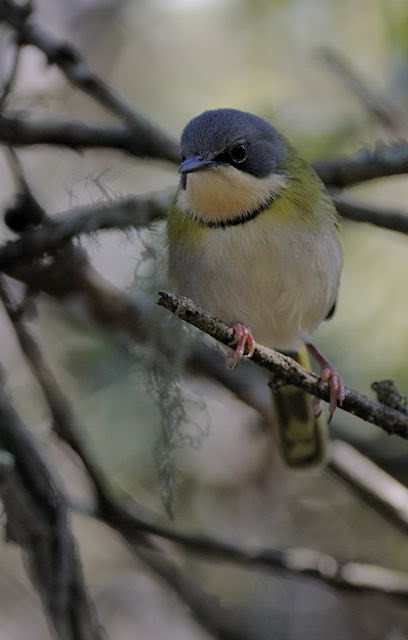
Female
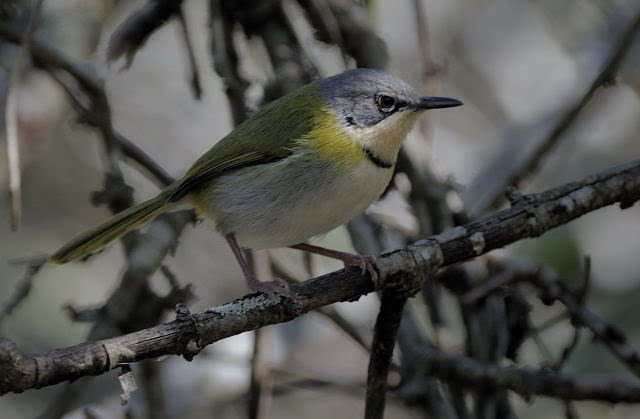
Female
Links:
Species text Sabap1
Sabap2
Chamberlain's LBJ's

Female

Female
Links:
Species text Sabap1
Sabap2
Chamberlain's LBJ's
Dewi
What is the good of having a nice house without a decent planet to put it on? (H D Thoreau)
What is the good of having a nice house without a decent planet to put it on? (H D Thoreau)
Yellow-breasted Apalis
648. Yellow-breasted Apalis Apalis flavida (Geelborskleinjantjie)
Order: Passeriformes. Family: Cisticolidae
Description
11-12 cm. Upperparts olive green. Head grey with red eye. Throat and belly white. Yellow breast with variably sized black spot along the bottom of the yellow in males in the South of their range, absent in females and males to the North of their range. Tail is long, olive green above and below, with yellow edges to the undertail feathers. Bills are grey and legs and feet are pinkish-brown. Juveniles are similar to the adults, but are paler yellow on the breast.
Distribution
In patches from Senegal to the Ethiopia through Tanzania to eastern South Africa, Mozambique, southern & northern Zimbabwe, northern Botswana and northern Namibia. The Yellow-breasted Apalis occurs in a narrow strip along the east coast littoral from c. 24°E eastwards through KwaZulu-Natal, Swaziland, the eastern Transvaal and southeastern Zimbabwe. The core of the distribution in southern Africa lies in KwaZulu-Natal north of Richards Bay, Swaziland and the eastern Transvaal, but also common in southeastern Zimbabwe, the Okavango Delta in Botswana and northwestern Kavango in Namibia.

Habitat
Forest and woodlands.
Diet
It mainly eats insects, often restlessly foraging in the foliage of the canopy, gleaning prey from leaves and twigs.
Breeding
The Yellow-breasted Apalis is monogamous and builds a hanging nest, often made of lichen that is bound together with spider web. Usually lined with spider web or soft grass, it is shaped like a ball and has a side entrance located near the top. Egg-laying season is from about October to March, peaking around October and November. The females lay a clutch of two or three eggs which are incubated by both sexes for about 12-14 days. The chicks are cared for by both adults, leaving the nest after about 15-17 days.
Call
The males and females call as a duet, often from a high perch in the early morning. The males call krunk-krunk-krunk and the females respond krik-krik-krik. Listen to Bird Call
Status
Common resident.

Male
Order: Passeriformes. Family: Cisticolidae
Description
11-12 cm. Upperparts olive green. Head grey with red eye. Throat and belly white. Yellow breast with variably sized black spot along the bottom of the yellow in males in the South of their range, absent in females and males to the North of their range. Tail is long, olive green above and below, with yellow edges to the undertail feathers. Bills are grey and legs and feet are pinkish-brown. Juveniles are similar to the adults, but are paler yellow on the breast.
Distribution
In patches from Senegal to the Ethiopia through Tanzania to eastern South Africa, Mozambique, southern & northern Zimbabwe, northern Botswana and northern Namibia. The Yellow-breasted Apalis occurs in a narrow strip along the east coast littoral from c. 24°E eastwards through KwaZulu-Natal, Swaziland, the eastern Transvaal and southeastern Zimbabwe. The core of the distribution in southern Africa lies in KwaZulu-Natal north of Richards Bay, Swaziland and the eastern Transvaal, but also common in southeastern Zimbabwe, the Okavango Delta in Botswana and northwestern Kavango in Namibia.

Habitat
Forest and woodlands.
Diet
It mainly eats insects, often restlessly foraging in the foliage of the canopy, gleaning prey from leaves and twigs.
Breeding
The Yellow-breasted Apalis is monogamous and builds a hanging nest, often made of lichen that is bound together with spider web. Usually lined with spider web or soft grass, it is shaped like a ball and has a side entrance located near the top. Egg-laying season is from about October to March, peaking around October and November. The females lay a clutch of two or three eggs which are incubated by both sexes for about 12-14 days. The chicks are cared for by both adults, leaving the nest after about 15-17 days.
Call
The males and females call as a duet, often from a high perch in the early morning. The males call krunk-krunk-krunk and the females respond krik-krik-krik. Listen to Bird Call
Status
Common resident.

Male
Dewi
What is the good of having a nice house without a decent planet to put it on? (H D Thoreau)
What is the good of having a nice house without a decent planet to put it on? (H D Thoreau)
Yellow-breasted Apalis Photos
648. Yellow-breasted Apalis Apalis flavida (Geelborskleinjantjie)
 © Dewi
© Dewi
Male, Tembe Elephant Park, KwaZulu-Natal
 © Dewi
© Dewi
Female
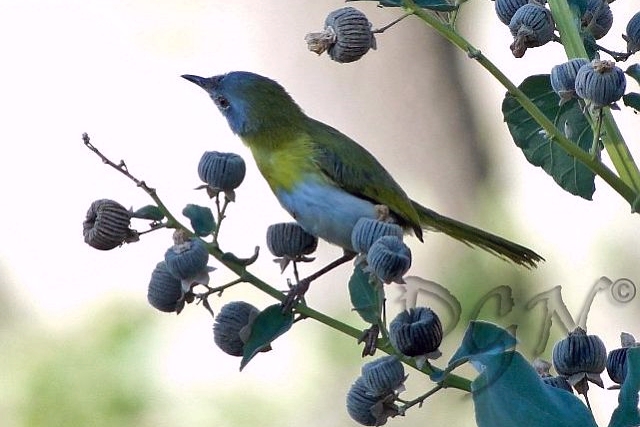 © JustN@ture
© JustN@ture
 © BluTuna
© BluTuna
Kruger National Park
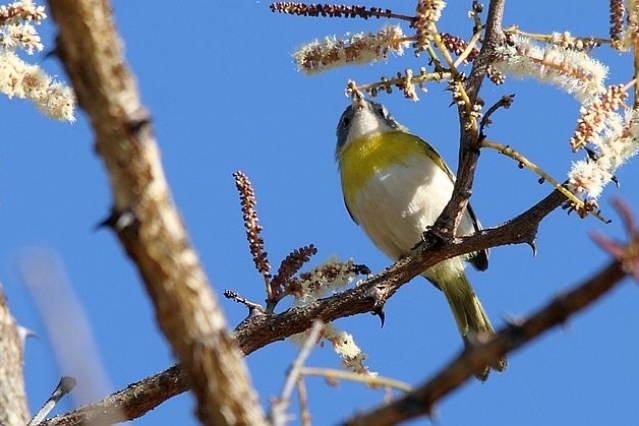 © Flutterby
© Flutterby
Kruger National Park
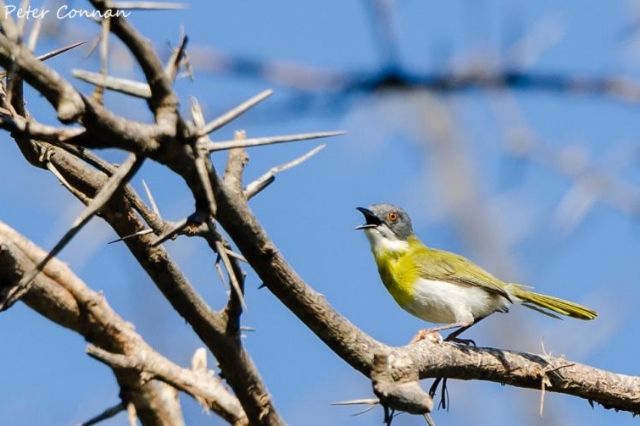 © Peter Connan
© Peter Connan
Maphelane, iSimangaliso Wetland Park, KwaZulu-Natal
Links:
Species text Sabap1
Sabap2
Chamberlain's LBJ's
 © Dewi
© DewiMale, Tembe Elephant Park, KwaZulu-Natal
 © Dewi
© DewiFemale
 © JustN@ture
© JustN@ture © BluTuna
© BluTunaKruger National Park
 © Flutterby
© FlutterbyKruger National Park
 © Peter Connan
© Peter ConnanMaphelane, iSimangaliso Wetland Park, KwaZulu-Natal
Links:
Species text Sabap1
Sabap2
Chamberlain's LBJ's
Dewi
What is the good of having a nice house without a decent planet to put it on? (H D Thoreau)
What is the good of having a nice house without a decent planet to put it on? (H D Thoreau)
Rufous-eared Warbler
688. Rufous-eared Warbler Malcorus pectoralis (Rooioorlangstertjie)
Order: Passeriformes. Family: Cisticolidae
Description
14-16 cm. Fairly small, prinia-like warbler with long, slender, graduated tail of only ten feathers, often cocked over back like that of prinia; face and ear coverts brick red (brighter in ♂; diagnostic); narrow black collar on throat (bolder in ♂; diagnostic).
Adult: Upperparts, incl upper wing coverts, buffy grey, streaked black. Supercilium whitish; lores, face and ear coverts bright brick red. Tail buffy brown, long, slender, and graduated; outer 3 pairs of rectrices with buffy edges to outer webs. Flight feathers dark brown, outer webs edged russet. Underwing coverts and axillaries pale buff. Underparts white to off-white, washed buff on flanks; lower throat with narrow black collar. Undertail coverts with dark streaks. Bill black; inside of mouth black in male. Eyes reddish hazel. Legs and feet pinkish.
Juvenile: Similar to adult; but rufous face patch indistinct, black collar indistinct or absent; tail shorter.
Distribution
Endemic to southern Africa, with the bulk of its population in west-central South Africa, extending into southern Namibia and Botswana.
Malcorus pectoralis is largely confined to the Karoo and southern Kalahari, with an isolated population around Etosha Pan in northern Namibia.
Habitat
It is especially common in low shrubby vegetation on dry mountain slopes, karoo and Kalahari plains and in dry watercourses along Namib edge. It typically occupies more open habitats, often running mouse-like over open ground with its tail cocked.
Diet
It mainly eats invertebrates supplemented with small fruit and seeds, often gleaning prey from the stems and leaves.
Breeding
The nest is an untidy oval shape with a side-top entrance, built of grey grass leaves and stems, or alternatively from strips of milkweed (Asclepias buchenaviana), reinforced with spider web and lined with plant down. It is typically placed up to 1 metre above ground in a bush or shrub, such as Driedoring (Rhigozum trichotomum), Doringvygie (Ruschia spinosa) and Bloubrakbossie (Galenia fruticosa). Egg-laying season is year round, but it generally lays its eggs after rainfall. It lays 2-7, usually 2-4 eggs, which are incubated for about 12-13 days. The chicks are fed by both parents, leaving the nest after about 11-13 days.
Call
Song monotonous penetrating piping tee-tee-tee-tee-tee, about 4 notes/second; plaintive peeeee alarm note.
Status
Common resident.
Order: Passeriformes. Family: Cisticolidae
Description
14-16 cm. Fairly small, prinia-like warbler with long, slender, graduated tail of only ten feathers, often cocked over back like that of prinia; face and ear coverts brick red (brighter in ♂; diagnostic); narrow black collar on throat (bolder in ♂; diagnostic).
Adult: Upperparts, incl upper wing coverts, buffy grey, streaked black. Supercilium whitish; lores, face and ear coverts bright brick red. Tail buffy brown, long, slender, and graduated; outer 3 pairs of rectrices with buffy edges to outer webs. Flight feathers dark brown, outer webs edged russet. Underwing coverts and axillaries pale buff. Underparts white to off-white, washed buff on flanks; lower throat with narrow black collar. Undertail coverts with dark streaks. Bill black; inside of mouth black in male. Eyes reddish hazel. Legs and feet pinkish.
Juvenile: Similar to adult; but rufous face patch indistinct, black collar indistinct or absent; tail shorter.
Distribution
Endemic to southern Africa, with the bulk of its population in west-central South Africa, extending into southern Namibia and Botswana.
Malcorus pectoralis is largely confined to the Karoo and southern Kalahari, with an isolated population around Etosha Pan in northern Namibia.
Habitat
It is especially common in low shrubby vegetation on dry mountain slopes, karoo and Kalahari plains and in dry watercourses along Namib edge. It typically occupies more open habitats, often running mouse-like over open ground with its tail cocked.
Diet
It mainly eats invertebrates supplemented with small fruit and seeds, often gleaning prey from the stems and leaves.
Breeding
The nest is an untidy oval shape with a side-top entrance, built of grey grass leaves and stems, or alternatively from strips of milkweed (Asclepias buchenaviana), reinforced with spider web and lined with plant down. It is typically placed up to 1 metre above ground in a bush or shrub, such as Driedoring (Rhigozum trichotomum), Doringvygie (Ruschia spinosa) and Bloubrakbossie (Galenia fruticosa). Egg-laying season is year round, but it generally lays its eggs after rainfall. It lays 2-7, usually 2-4 eggs, which are incubated for about 12-13 days. The chicks are fed by both parents, leaving the nest after about 11-13 days.
Call
Song monotonous penetrating piping tee-tee-tee-tee-tee, about 4 notes/second; plaintive peeeee alarm note.
Status
Common resident.
Rufous-eared Warbler Photos
688. Rufous-eared Warbler Malcorus pectoralis
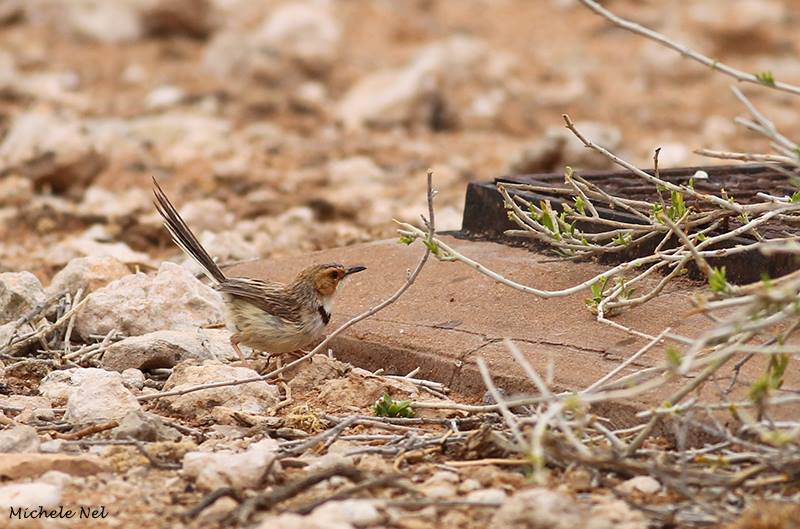 © Michele Nel
© Michele Nel
Kgalagadi Transfrontier Park, Auchterlonie, 28/12/2015
Links:
Species text Sabap1
Sabap2
 © Michele Nel
© Michele NelKgalagadi Transfrontier Park, Auchterlonie, 28/12/2015
Links:
Species text Sabap1
Sabap2
Green-backed Camaroptera
657a. Green-backed Camaroptera (formerly known as Bleating Warbler) Camaroptera brachyura (Groenrugkwêkwêvoël)
Order: Passeriformes. Family: Cisticolidae
Description
Length 10-11 cm. A small, active, noisy warbler with olive-green wings and olive-green or grey mantle, back and tail. The head is grey and the underparts are white. It has a habit of cocking its tail. Dark eye. The sexes are similar.
Juveniles are paler yellow on the breast and slightly streaked below.
Similar species: Told from Grey-backed Camaroptera C. brevicaudata by the olive-green (not grey) crown, mantle and back, but the green wings are common to both. (The Grey-backed Camaroptera prefers the more arid western parts of the subregion, whereas the Green-backed Camaroptera occurs in the moister eastern parts.)
Distribution
Endemic to southern Africa, occurring from southern Mozambique to the Limpopo Province, Mpumalanga, Swaziland, KwaZulu-Natal and the Eastern Cape.
Habitat
It generally prefers moist bush near watercourses in savanna woodland, also occurring along forest edges, gardens and parks.
Diet
It mainly eats invertebrates, doing most of its foraging in the forest undergrowth, often catching prey disturbed by humans.
Breeding
The nest is built by both sexes, consisting of a ball-shaped structure made of leaves attached together with spider web, lined with finer material such as grass. It is typically placed in a clump of grass, low shrub or sapling, anwhere from ground level to about 2, rarely up to 6m up. Egg-laying season is from September-February, peaking from October-December. It lays 2-4 eggs, which are incubated by both sexes for about 14-15 days. The chicks are fed by both adults, staying in the nest for roughly 14-15 days.
Call
Calls include a loud, snapping bidup-bidup-bidup and a nasal, "bleating" neeehh. Listen to Bird Call.
Status
Resident.
Order: Passeriformes. Family: Cisticolidae
Description
Length 10-11 cm. A small, active, noisy warbler with olive-green wings and olive-green or grey mantle, back and tail. The head is grey and the underparts are white. It has a habit of cocking its tail. Dark eye. The sexes are similar.
Juveniles are paler yellow on the breast and slightly streaked below.
Similar species: Told from Grey-backed Camaroptera C. brevicaudata by the olive-green (not grey) crown, mantle and back, but the green wings are common to both. (The Grey-backed Camaroptera prefers the more arid western parts of the subregion, whereas the Green-backed Camaroptera occurs in the moister eastern parts.)
Distribution
Endemic to southern Africa, occurring from southern Mozambique to the Limpopo Province, Mpumalanga, Swaziland, KwaZulu-Natal and the Eastern Cape.
Habitat
It generally prefers moist bush near watercourses in savanna woodland, also occurring along forest edges, gardens and parks.
Diet
It mainly eats invertebrates, doing most of its foraging in the forest undergrowth, often catching prey disturbed by humans.
Breeding
The nest is built by both sexes, consisting of a ball-shaped structure made of leaves attached together with spider web, lined with finer material such as grass. It is typically placed in a clump of grass, low shrub or sapling, anwhere from ground level to about 2, rarely up to 6m up. Egg-laying season is from September-February, peaking from October-December. It lays 2-4 eggs, which are incubated by both sexes for about 14-15 days. The chicks are fed by both adults, staying in the nest for roughly 14-15 days.
Call
Calls include a loud, snapping bidup-bidup-bidup and a nasal, "bleating" neeehh. Listen to Bird Call.
Status
Resident.
Green-backed Camaroptera Photos
657a. Green-backed Camaroptera Camaroptera brachyura
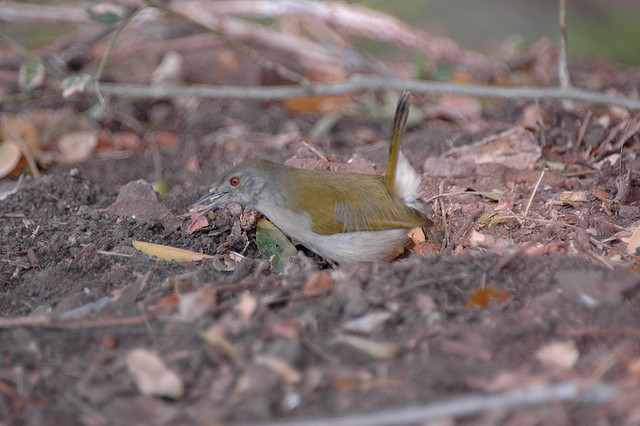 © Grumpy
© Grumpy
 © Grumpy
© Grumpy
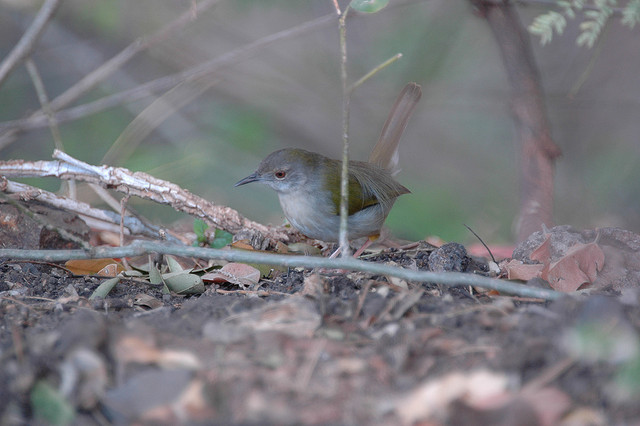 © Grumpy
© Grumpy
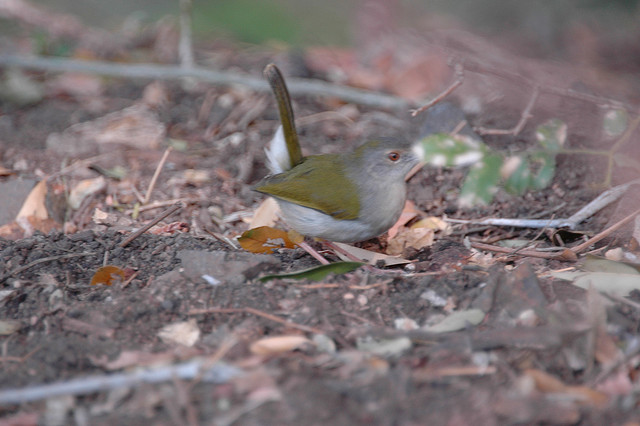 © Grumpy
© Grumpy
Links:
Sabap2
 © Grumpy
© Grumpy © Grumpy
© Grumpy © Grumpy
© Grumpy © Grumpy
© GrumpyLinks:
Sabap2
- Flutterby
- Posts: 44029
- Joined: Sat May 19, 2012 12:28 pm
- Country: South Africa
- Location: Gauteng, South Africa
- Contact:
Grey-backed Camaroptera
657b. Grey-backed Camaroptera (previously known as Grey-backed Bleating Warbler) Camaroptera brevicaudata (Grysrugkwekwevoel)
Order: Passeriformes. Family: Cisticolidae
Description
13 cm. A small, rotund bird with a short tail that is often held cocked over its back. The head is grey, the back wings and tail are olive green; the throat is white; the bill black; legs and feet are pink and the eyes are brown. Upperparts ashy brown, flight feathers paler in non-breeding season. Sexes are alike.
Adult breeding: Forehead to hind neck, lores, cheeks and ear coverts greyish brown. Mantle, back and rump lead grey, rump feathers tipped paler grey. Upper tail coverts and tail brown. Upper wing coverts brown, broadly edged yellowish olive. Flight feathers dark brown; inner edges of primaries paler brown, outer edges of secondaries and P1-P8 yellowish olive. Marginal and lesser upper wing coverts yellow, axillaries and remaining coverts white. Chin to upper breast pale grey, sparingly mottled buff; lower breast, belly and flanks buffy white. Sides of belly and flanks washed grey; thighs orange-buff. Bill greenish black, black or dark horn. Eyes brown or hazel to pale buff or orange. Legs and feet fleshy pink, pale brown or pale pinkish brown.
Juveniles have olive-brown upperparts and are streaked below.
Similar species: Easily separated from Green-backed Camaroptera during breading season by grey back and crown.
It might be confused with Karoo Eremomela, which frequents much drier habitats, but the Koroo Eremomela has a much longer tail, yellow-washed flanks and a pale (not dark) eye.
Distribution
Across much of sub-Saharan Africa, from Senegal to Ethiopia south to southern Africa. Here it is common from Namibia, northern and south-eastern Botswana to Zimbabwe, central Mozambique, Limpopo Province, North-West Province and Gauteng.
Habitat
Dry woodland, thornveld.
Diet
The Grey-backed Camaroptera usually forages on the ground, gleaning from leaves and stems, eating insects such as butterflies, locusts, ants, bees and wasps.
Breeding
The Grey-backed Camaroptera is monogamous, and is a solitary nester. During breeding they are very territorial and nests are widely spaced as a result. The ball-shaped nest with a top entrance, is built low down in a bush or tree, or even on the ground, and is always well hidden. It is constructed by binding growing leaves together with spider webs, and lining it with dry grass. Egg-laying season is from October-April, peaking around November-December.
The female lays two to four white to greenish-blue eggs that hatch after an incubation period of approximately 11 days. The chicks stay in the nest for about 13-15 days, after which it leaves (before being able to fly). Before fledging full it follows its parents around through the undergrowth.
The nests are sometimes parasitized by Klaas’s Cuckoo, Diderick Cuckoo and African Emerald Cuckoo.
Call
Very vocal, with a loud, penetrating call that sounds like two stones being tapped together – kwit-kwit-kwit. Listen to Bird Call.
Status
A common resident.
Order: Passeriformes. Family: Cisticolidae
Description
13 cm. A small, rotund bird with a short tail that is often held cocked over its back. The head is grey, the back wings and tail are olive green; the throat is white; the bill black; legs and feet are pink and the eyes are brown. Upperparts ashy brown, flight feathers paler in non-breeding season. Sexes are alike.
Adult breeding: Forehead to hind neck, lores, cheeks and ear coverts greyish brown. Mantle, back and rump lead grey, rump feathers tipped paler grey. Upper tail coverts and tail brown. Upper wing coverts brown, broadly edged yellowish olive. Flight feathers dark brown; inner edges of primaries paler brown, outer edges of secondaries and P1-P8 yellowish olive. Marginal and lesser upper wing coverts yellow, axillaries and remaining coverts white. Chin to upper breast pale grey, sparingly mottled buff; lower breast, belly and flanks buffy white. Sides of belly and flanks washed grey; thighs orange-buff. Bill greenish black, black or dark horn. Eyes brown or hazel to pale buff or orange. Legs and feet fleshy pink, pale brown or pale pinkish brown.
Juveniles have olive-brown upperparts and are streaked below.
Similar species: Easily separated from Green-backed Camaroptera during breading season by grey back and crown.
It might be confused with Karoo Eremomela, which frequents much drier habitats, but the Koroo Eremomela has a much longer tail, yellow-washed flanks and a pale (not dark) eye.
Distribution
Across much of sub-Saharan Africa, from Senegal to Ethiopia south to southern Africa. Here it is common from Namibia, northern and south-eastern Botswana to Zimbabwe, central Mozambique, Limpopo Province, North-West Province and Gauteng.
Habitat
Dry woodland, thornveld.
Diet
The Grey-backed Camaroptera usually forages on the ground, gleaning from leaves and stems, eating insects such as butterflies, locusts, ants, bees and wasps.
Breeding
The Grey-backed Camaroptera is monogamous, and is a solitary nester. During breeding they are very territorial and nests are widely spaced as a result. The ball-shaped nest with a top entrance, is built low down in a bush or tree, or even on the ground, and is always well hidden. It is constructed by binding growing leaves together with spider webs, and lining it with dry grass. Egg-laying season is from October-April, peaking around November-December.
The female lays two to four white to greenish-blue eggs that hatch after an incubation period of approximately 11 days. The chicks stay in the nest for about 13-15 days, after which it leaves (before being able to fly). Before fledging full it follows its parents around through the undergrowth.
The nests are sometimes parasitized by Klaas’s Cuckoo, Diderick Cuckoo and African Emerald Cuckoo.
Call
Very vocal, with a loud, penetrating call that sounds like two stones being tapped together – kwit-kwit-kwit. Listen to Bird Call.
Status
A common resident.
- Flutterby
- Posts: 44029
- Joined: Sat May 19, 2012 12:28 pm
- Country: South Africa
- Location: Gauteng, South Africa
- Contact:
Grey-backed Camaroptera Photos
657b. Grey-backed Camaroptera Camaroptera brevicaudata
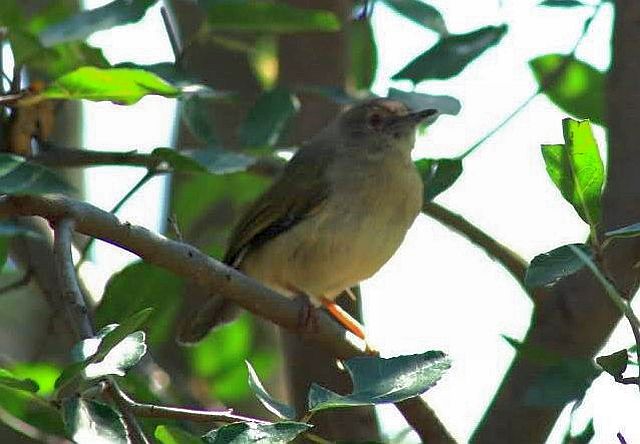 © Flutterby
© Flutterby
Pilanesberg
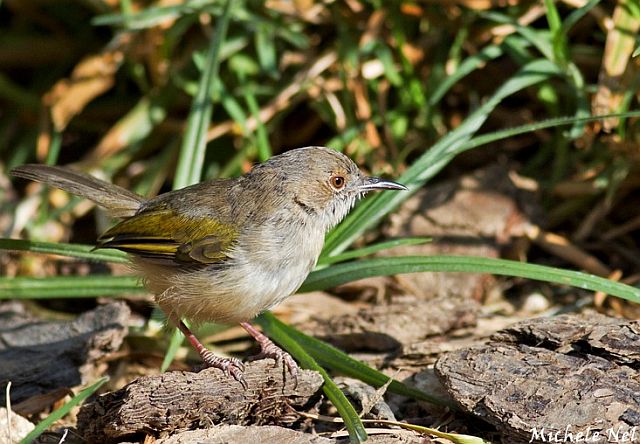 © Michele Nel
© Michele Nel
Links:
Sabap2
 © Flutterby
© FlutterbyPilanesberg
 © Michele Nel
© Michele NelLinks:
Sabap2


